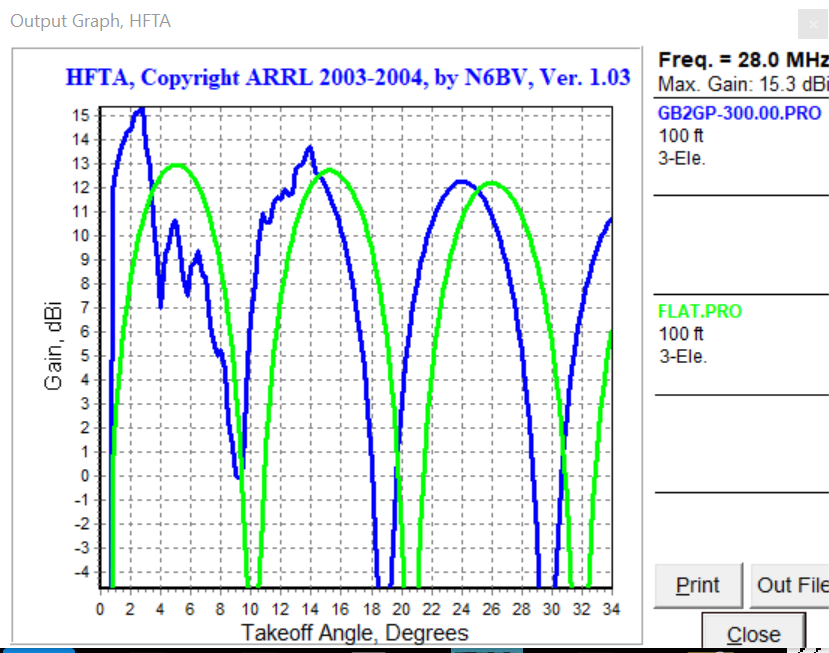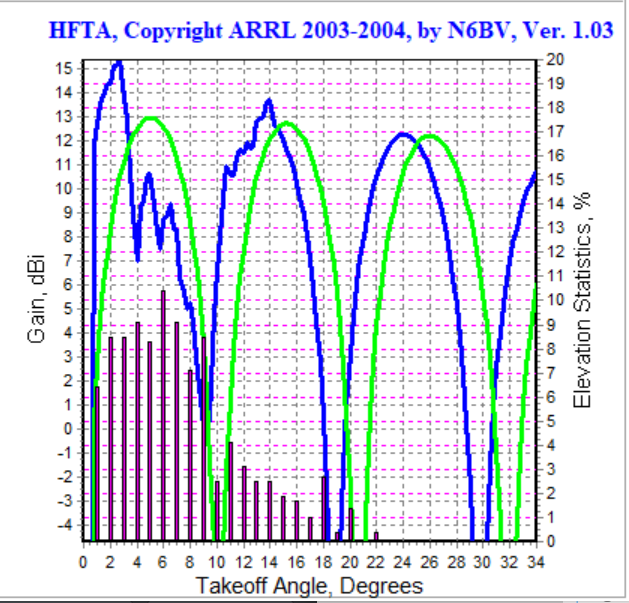
A popular YouTuber was speaking recently about how we should use vertical antennas to “command DX” as their primary lobes are at low angles, he uses gain at 5 degrees to promote the antennas we sells. This reminded me of some work by N6BV published in the ARRL Antenna Handbook which demonstrated that your terrain also has a substantial impact on the lobes of your antenna. This led me to consider what the effects of the terrain at GB2GP has upon on the performance of our antennas.
There is nothing new here; N6BV created some modelling software called HF Terrain Analysis (HFTA) which plots the gain of typical horizontal antennas over your specific terrain and can compare it to flat earth. We are pretty lucky that Gilwell Park is on a local high spot so it will be interesting to see how the slopes that are in several directions have an impact.
The image below is a typical HFTA output and compares the gain of a 3 element, 28MHz yagi at 100ft over the terrain at Gilwell Park (blue line) beaming to north America, compared to the same antenna over flat ground (green line). The terrain give a clear advantage at 2 degree take off angle, +7dBi, but a 2.5bDi disadvantage at the 5 degrees.
Generating the terrain profiles for HFTA) has generally been a serious undertaking, but luckily K6TU has done us all a great service by automating this on his website https://k6tu.net/?q=TerrainProfiles. I have used these and thank him for making these publicly available.
Antenna height has a substantial impact on take of angles for horizontal antennas and we are fortunate at GB2GP to have three towers for HF yagis at 60, 80 and 100ft. Would swapping the antennas round offer any significant advantage on any particular contest band? The following posts simulates our current antennas at each height in key directions.
HFTA also includes take off (or arrival) angle data for signals over specific paths. Whilst 5 degrees cited in the opening paragraph might work as a rule of thumb, it’s a long way from the full picture as the Angle of Arrival changes with ionospheric conditions and HFTA plots the percentage probability of different arrival angles on a second y axis. This data suggests that we all need different antennas to suit every set of conditions, but acknowledging the real world, HFTA also includes a coarse judge of quality that amalgamates the gain over your terrain with the Angle of Arrival profile to help us decide which configuration is best.
The graph below shows the same set of antennas and direction with elevation statistics for the same path. 8% of signals arrive at 2 degrees where our 3 element yagi at 100ft has a terrain advantage, but similar percentage of signals arrive at 5 degrees where we have a disadvantage over flat terrain.
There is nothing new here; N6BV created some modelling software called HF Terrain Analysis (HFTA) which plots the gain of typical horizontal antennas over your specific terrain and can compare it to flat earth. We are pretty lucky that Gilwell Park is on a local high spot so it will be interesting to see how the slopes that are in several directions have an impact.
The image below is a typical HFTA output and compares the gain of a 3 element, 28MHz yagi at 100ft over the terrain at Gilwell Park (blue line) beaming to north America, compared to the same antenna over flat ground (green line). The terrain give a clear advantage at 2 degree take off angle, +7dBi, but a 2.5bDi disadvantage at the 5 degrees.
Generating the terrain profiles for HFTA) has generally been a serious undertaking, but luckily K6TU has done us all a great service by automating this on his website https://k6tu.net/?q=TerrainProfiles. I have used these and thank him for making these publicly available.
Antenna height has a substantial impact on take of angles for horizontal antennas and we are fortunate at GB2GP to have three towers for HF yagis at 60, 80 and 100ft. Would swapping the antennas round offer any significant advantage on any particular contest band? The following posts simulates our current antennas at each height in key directions.
HFTA also includes take off (or arrival) angle data for signals over specific paths. Whilst 5 degrees cited in the opening paragraph might work as a rule of thumb, it’s a long way from the full picture as the Angle of Arrival changes with ionospheric conditions and HFTA plots the percentage probability of different arrival angles on a second y axis. This data suggests that we all need different antennas to suit every set of conditions, but acknowledging the real world, HFTA also includes a coarse judge of quality that amalgamates the gain over your terrain with the Angle of Arrival profile to help us decide which configuration is best.
The graph below shows the same set of antennas and direction with elevation statistics for the same path. 8% of signals arrive at 2 degrees where our 3 element yagi at 100ft has a terrain advantage, but similar percentage of signals arrive at 5 degrees where we have a disadvantage over flat terrain.

 RSS Feed
RSS Feed
